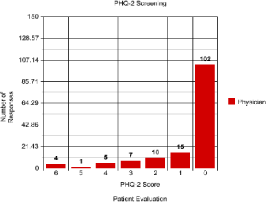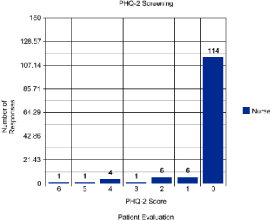Abstract
Our investigation was whether physician administration of the PHQ-2 to patients of the Family Medicine Residency Clinic improves the identification of patients with undiag- nosed depression, as compared to our current practice of having the registered nurse administer the PHQ-2.
Keywords: PHQ-2; Screening; Depression; Primary Care
Introduction
There are many barriers to depression screening in any field you are in. However, an important barrier is patient trust during the administration of the questionnaire. The degree of trust a patient has for a provider significantly impacts how willing the patient is to discuss sensitive topics. The questions asked by the PHQ-2 fall under the purview of sensitive topics. The PHQ-2 enquires about the frequency of depressed mood and anhedonia over the past 2 weeks. The PHQ-2 includes the first two items of the PHQ-9, and a positive screening with this shorter questionnaire initiates a screening with the more detailed PHQ-9. The PHQ-2 is a good screening tool with a sensitivity of 86% and a specificity of 78% when self-administered in a Family Practice setting [1]. A PHq-2 Score ranges from 0-6. The authors identified a PHQ-2 cutoff score of 3 as the optimal cut point for screening purposes [2].
However, when the questionnaire is being administered by a provider such as a registered nurse, factors such as patient trust and the time spent discussing the questionnaire may influence the honesty of the responses given. What is currently unknown is the extent to which the degree of trust between patient and provider impacts the false negative rate in this population. Specifically, will a patient be more likely to disclose having feelings of depressed mood and anhedonia to a physician with whom they are familiar, as opposed to a registered nurse whom they may not have met before.
Methods
The setting was the Family Practice Center in Glen Cove, Part of the Family Medicine Residency Program at Northwell/Hofstra Donald and Barbara Zucker School of Medicine. Those who were willing to participate were provided a separate room for patient interview. The study took place from October 30 through November 17. Patients were approached in the examining room and asked to participate in the study by either physician or registered nurse. The PHQ-2 has 2 questions with a score ranging from 0 to 3 for each question (maximum score of 6). A threshold score of 3 or higher is considered to indicate a positive screen for possible depression, so if their score is positive (if they score 3 or more), the patients completed the PHQ-9 assessment.
Results
There is a potential benefit of shorter time to treatment for depression for the participants in this study, especially in the Hispanic population. The Finding are:
A total of 277 patients were approached and a total of 277 patients information were used for analysis.
The prevalence of a positive screen for major depression in the past three weeks determined by this questionnaire was 8.6%. The overall study was found to be statistically significant (Figure 1).

Figure 1:
It was noted that the prevalence of a positive PHQ-2 screen administered by the physician was 11.8% out of 144, which included 17 PHQ-2 scores equal to or greater than 3. Compared to the registered nurse analysis, it was noted that the prevalence of a positive PHQ-2 screen was 5.2% out of 133, which included again 7 PHQ-2 scores equal to or greater than 3 (Figure 2).

Figure 2:
Discussion
We report the assessment of the PHQ-2 in an exclusively primary care population focusing on the interviewee and the possible discrepancies that can arise based on this process of the PHQ-2 interview. PHQ-2 is a good screening tool with a sensitivity of 86% and a specificity of 78% when self-administered in a Family Practice setting [1]. Based on the findings above, clinicians who wish to screen their patients for depression, we suggest the physician ask patients to respond to the first 2 questions of the PHQ-9 (ie, the PHQ-2). If their score is positive (if they score 3 or more), the patients should then complete the PHQ-9.
References
- Arrol B, Goodyear-Smith F, Crengle S, Gunn J, Kerse N, Fishman T, et al. Validation of PHQ-2 and PHQ-9 to Screen for Major Depression in the Primary Care Population. Ann Fam Med. 2010; 8: 348-353.
- Kroenke K, Spitzer RL, Williams JB. The Patient health Questionaire-2: Validity of a Two-Item Depression Screener. Medical Care. 2003; 41: 1284- 1292.
